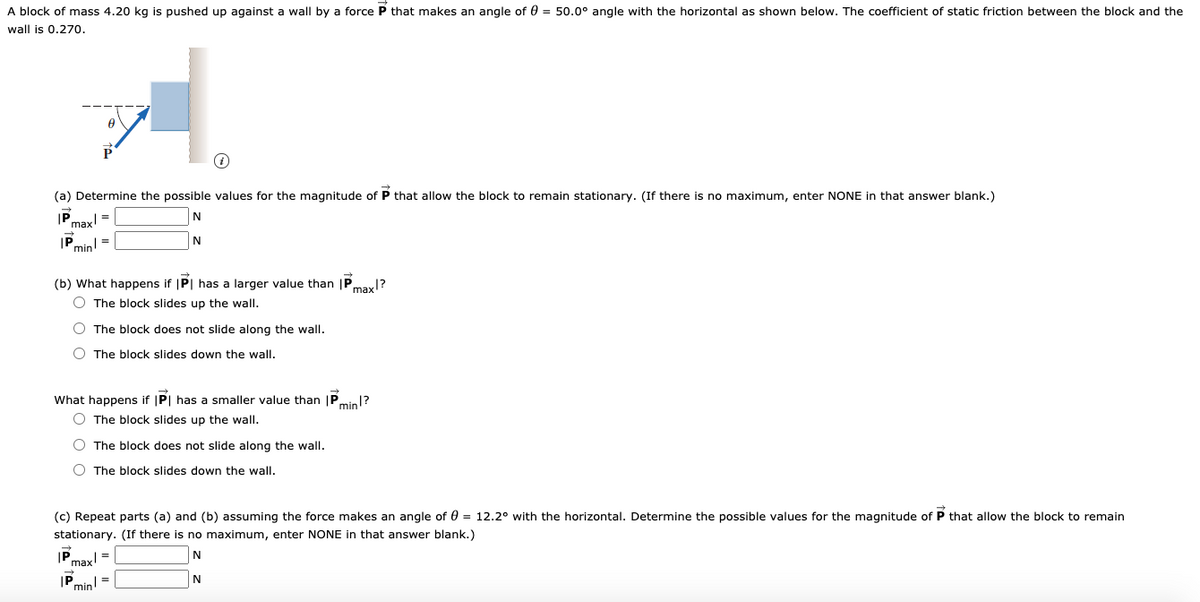A block of mass 4.20 kg is pushed up against a wall by a force P that makes an angle of 0 = 50.0° angle with the horizontal as shown below. The coefficient of static friction between the block and the wall is 0.27o. (a) Determine the possible values for the magnitude of P that allow the block to remain stationary. (If there is no maximum, enter NONE in that answer blank.) max/ |Pmin!= N N (b) What happens if |P| has a larger value than |P, O The block slides up the wall. max1? O The block does not slide along the wall. O The block slides down the wall. What happens if |P| has a smaller value than |Pminl? O The block slides up the wall. O The block does not slide along the wall. O The block slides down the wall. (c) Repeat parts (a) and (b) assuming the force makes an angle of 0 = 12.2° with the horizontal. Determine the possible values for the magnitude of P that allow the block to remain stationary. (If there is no maximum, enter NONE in that answer blank.) IP. max | = N |Pmin =
A block of mass 4.20 kg is pushed up against a wall by a force P that makes an angle of 0 = 50.0° angle with the horizontal as shown below. The coefficient of static friction between the block and the wall is 0.27o. (a) Determine the possible values for the magnitude of P that allow the block to remain stationary. (If there is no maximum, enter NONE in that answer blank.) max/ |Pmin!= N N (b) What happens if |P| has a larger value than |P, O The block slides up the wall. max1? O The block does not slide along the wall. O The block slides down the wall. What happens if |P| has a smaller value than |Pminl? O The block slides up the wall. O The block does not slide along the wall. O The block slides down the wall. (c) Repeat parts (a) and (b) assuming the force makes an angle of 0 = 12.2° with the horizontal. Determine the possible values for the magnitude of P that allow the block to remain stationary. (If there is no maximum, enter NONE in that answer blank.) IP. max | = N |Pmin =
Principles of Physics: A Calculus-Based Text
5th Edition
ISBN:9781133104261
Author:Raymond A. Serway, John W. Jewett
Publisher:Raymond A. Serway, John W. Jewett
Chapter5: More Applications Of Newton’s Laws
Section: Chapter Questions
Problem 61P
Related questions
Topic Video
Question
A block of mass 4.20 kg is pushed up against a wall by a force P that makes an angle of θ = 50.0°angle with the horizontal as shown below. The coefficient of static friction between the block and the wall is 0.270.

Transcribed Image Text:(c) Repeat parts (a) and (b) assuming the force makes an angle of 0 = 12.2° with the horizontal. Determine the possible values for the magnitude of P that allow the block to remain
stationary. (If there is no maximum, enter NONE in that answer blank.)
IP.
max!
IP,
"min!=
N
What happens if |P| has a larger value than |P,
O The block slides up the wall.
max?
The block does not slide along the wall.
O The block slides down the wall.
What happens if |P| has a smaller value than |P,
min1?
O The block slides up the wall.
O The block does not slide along the walI.
O The block slides down the wall.

Transcribed Image Text:A block of mass 4.20 kg is pushed up against a wall by a force P that makes an angle of 0 = 50.0° angle with the horizontal as shown below. The coefficient of static friction between the block and the
wall is 0.270.
(a) Determine the possible values for the magnitude of P that allow the block to remain stationary. (If there is no maximum, enter NONE in that answer blank.)
IP
max=
|Pmin!
(b) What happens if |P| has a larger value than P
max1?
The block slides up the wall.
O The block does not slide along the wall.
O The block slides down the wall.
What happens if |P| has a smaller value than |P,
min1?
O The block slides up the wall.
The block does not slide along the wall.
The block slides down the wall.
(c) Repeat parts (a) and (b) assuming the force makes an angle of 0 = 12.2° with the horizontal. Determine the possible values for the magnitude of P that allow the block to remain
stationary. (If there is no maximum, enter NONE in that answer blank.)
|P max
N
|Pmin =
Expert Solution
This question has been solved!
Explore an expertly crafted, step-by-step solution for a thorough understanding of key concepts.
This is a popular solution!
Trending now
This is a popular solution!
Step by step
Solved in 5 steps with 8 images

Knowledge Booster
Learn more about
Need a deep-dive on the concept behind this application? Look no further. Learn more about this topic, physics and related others by exploring similar questions and additional content below.Recommended textbooks for you

Principles of Physics: A Calculus-Based Text
Physics
ISBN:
9781133104261
Author:
Raymond A. Serway, John W. Jewett
Publisher:
Cengage Learning

Principles of Physics: A Calculus-Based Text
Physics
ISBN:
9781133104261
Author:
Raymond A. Serway, John W. Jewett
Publisher:
Cengage Learning